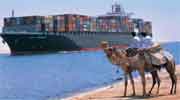| |
|
| |
|
 |
Supply
Chain by the Numbers |
| |
|
| |
- Oct. 27, 2016 -
|
| |
|
| |
|
| |
|
| |
Reebok Latest Shoe Maker to Shift Production to the US; Best Buy Goes for Free Shipping Again this Year; Scary Economic Projection on When US Budget Goes Bust; Suez Canal Says Pay Me Now |
| |
|
| |
| |
| |
100% |

|
|
|
| |
| |
|
$0.00
|
 |
That is how much electronics retail giant Best Buy will be charging for shipping for on-line purchases during the Christmas shopping season for the second year in a row. Normally, the threshold for free shipping is an order value of $35, but this shipping promotion went live on Sunday. It will end on Dec. 24, about a week earlier than last year when it ran through Jan. 2. It is certainly a move to keep pace with Amazon and its Prime service, but given that many orders for Best Buy exceed that $35 threshold it is not clear how big an impact the free shipping really has on revenue. Last year, on-line sales accounted for 15.6% of Best Buy's US sales in the fourth quarter, including the holiday period. We'll just say that for those under-$35 orders, that free shipping will make it hard to make a profit, though Best Buy has increasingly been shipping orders from its stores rather than a DC to reduce shipping costs and speed delivery. |
| |
| |
|
| |
| |
$3.18 Billion |
 |
That is how much revenue the Suez Canal generated in tolls in the first half of 2016 from both container ships and bulk vessels hauling oil or other commodities, according to figures from the Egyptian government. That was actually up about 4% from 2015 - not bad in a period of weak container volumes and falling oil shipments - but not so good when considering the Canal Authority spent $4 billion last year to deepen the waterway, introducing two-way traffic in August 2015 and vastly increasing the Canal's capacity. It was hoping for a greater return on that investment. We were interested in that number on 1H toll fees, because we really had no idea what the Canal’s revenues were. But also interesting is that the Canal Authority confirms it is in talks with the world's biggest container shipping operators to receive payments for future tolls now - 3-5 years in advance - in exchange for something like a 3% discount in rates. Maersk Line, MSC, and CMA CGM are said to be involved in the talks. SCDigest says it would take more than a 3% discount for us to fork over all that cash now. The Canal is looking to lock up business in the face of the threat from the expanded Panama Canal. |
| |
| |
|
|
|
| |
 |
 |
| |
|
|
| |